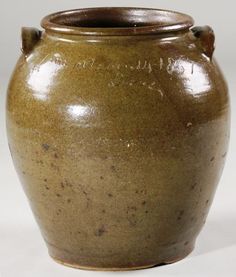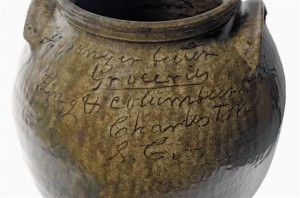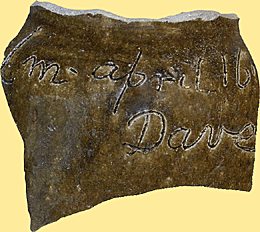The
Pottery of Dave the Potter
by Bob Brooke
"I made this Jar all
of cross
If you don't repent, you will be lost." Dave
 This
inscription graces a plain stoneware jar made in May, 1862, by the
elusive slave potter Dave. Today, it’s part of the enormous collection
of the Smithsonian Institution. But when Dave created it, this jar was
just one of thousands produced by slaves in the potteries of the
Edgefield District of South Carolina. This
inscription graces a plain stoneware jar made in May, 1862, by the
elusive slave potter Dave. Today, it’s part of the enormous collection
of the Smithsonian Institution. But when Dave created it, this jar was
just one of thousands produced by slaves in the potteries of the
Edgefield District of South Carolina.
Often called “Dave pots,” these vessels have sparked the interest of
pottery collectors in recent years because they’re signed, dated and
made by an enslaved African-American. So what makes Dave’s jars stand
out from all the others? For one thing, they’re some of the largest
ceramic vessels made in the 19th century. But, more importantly, they’re
distinguished by the poetic verse inscribed on them.
Hunched over his wheel day after day, the enslaved African-American
potter known simply as Dave created an astonishing 40,000 or more
stoneware jars, jugs, and other storage containers, ranging in size from
one quart to 40 gallons, during his lifetime. Born into slavery in South
Carolina in about 1800, Dave was owned by Harvey Drake by the time he
was 18. Drake ran a pottery with Abner and Amos Landrum on the outskirts
of Edgefield in a community called Pottersville.
Dave and his more than 50 fellow enslaved potters were often traded
among various owners throughout their lifetimes. Lewis Miles, the owner
of a pottery called Miles Mill, purchased him in 1833. As a young,
fast-working and strong potter who could move more than 50 or 60 pounds
of wet clay on and off the wheel without much difficulty, Dave became
recognized by pottery owners like Miles as a valuable asset.
Although records indicate Benjamin Franklin Landrum bought Dave in 1847
for $700, Landrum sold him back to Miles, who was married to Landrum’s
sister, Sarah, two years later. Dave remained at Miles Mill pottery for
the rest of his life, taking the surname Drake--his first owner’s
surname–after emancipation. Because his name disappears from U.S. Census
records after the 1870 listing, experts presume he died shortly
thereafter.
With its rich deposits of high quality clay, the region surrounding
Edgefield, South Carolina, became the site of numerous potteries
starting in the early 19th century. Abner Landrum built the first one
between 1810 and 1820, and the town, appropriately named Pottersville,
grew up around it. These potteries were family-owned establishments that
employed both paid and slave laborers and produced enormous quantities
or utilitarian wares.
Archaeologists have linked Dave to at least five of these pottery sites,
four of which have been excavated. He was taught to turn pots by either
Abner Landrum or Harvey Drake. Landrum, a physician, potter; and
newspaper editor, may also have been responsible for Dave’s unique, but
illegal, literacy.
South Carolina's Edgefield District is widely known for its
alkaline-glazed stoneware. Home of Francis Pickens and John Hammond,
strong supporters of radical nullifier John C. Calhoun, the district was
a hotbed of secessionist sentiment. The local newspaper, The Edgefield
Hive, served as a venue to expound the liberal views and pro-union
stance of its owner, Dr. Abner Landrum. Dave worked with Landrum, and
perhaps because of his liberal views, Landrum taught Dave to read and
write while he worked as a typesetter at Landrum’s newspaper, The
Edgefield Hive.
Dave worked for 40 years in Edgefield. creating thousands of vessels
used to preserve and store food on large southern plantations. The food
storage jars made by Dave and other potters were in high demand by both
local plantations and customers from outside the district, from such
places as Charleston and Georgia.
 Dave
fashioned the native stoneware clay into durable, utilitarian vessels
bathed in glossy, olive green and reddish-brown alkaline glazes. By the
late 1850s, he became skilled enough to fashion enormous vessels that
could hold more than 25 gallons and were up to 29 inches tall. These
were pieced together--the base turned on a wheel and the body attached
in sections joined by coils. Dave
fashioned the native stoneware clay into durable, utilitarian vessels
bathed in glossy, olive green and reddish-brown alkaline glazes. By the
late 1850s, he became skilled enough to fashion enormous vessels that
could hold more than 25 gallons and were up to 29 inches tall. These
were pieced together--the base turned on a wheel and the body attached
in sections joined by coils.
But the story of Dave the Potter is much more than that of a proficient
artist working in stoneware, for Dave was also a literate, clever poet
at a time when it was illegal for slaves in the South to read or write.
By inscribing many of his pieces with thought-provoking couplets or
simply signing them with a grand flourish, Dave, this master craftsman,
unlike his fellow enslaved potters, boldly identified himself and
expressed his feelings on a wide range of subjects--friendship, loss,
freedom, religion and current events.
Using rhyming, vernacular language, he breathed life into these
otherwise utilitarian wares, which still captivate with their charm and
poignancy more than 150 years later. One of his pots, dated in March 27,
1836, proclaims “Horses, mules and hogs! our cows is in the bogs;/ there
they shall ever stay,! till the buzzards takes them away.”
By 1840, Dave’s bold signature graced the surfaces of many vessels, and
his verses became more assured. “Give me silver or either gold/though
they are dangerous to our soul,” proclaims another inscription, while
the reverse reads “Mr. L. Miles 27tb June: 1840/ Dave.”
Troubling gaps in writing and dating appear between 1846 and 1848, when
Dave was owned by Benjamin Franklin Landrum, which raises the
possibility that Landrum might not have looked favorably on his slave’s
literacy and independent spirit–and sought to silence it.
 When
Dave returned to Miles Mill in the 1850s, however, his characteristic
signature and verses reappeared with ‘renewed vigor–“I wonder where is
all my relations/Friendship to all - and every nation (August 16,
1857)–and remained throughout his final works during the 1860s. When
Dave returned to Miles Mill in the 1850s, however, his characteristic
signature and verses reappeared with ‘renewed vigor–“I wonder where is
all my relations/Friendship to all - and every nation (August 16,
1857)–and remained throughout his final works during the 1860s.
Dave’s work has been known for some time but much new information has
come to light recently through research and archaeological
investigation. Although he was still alive as late at 1870, he produced
most of his pottery between 1834 and 1864.
No pieces dating between 1840 and 1857 bearing a poetic inscription have
been located, but with the exception of the years 1842, 1844,1846-1848,
and 1855, Dave did sign and date his work. Starting in the 1850s, when
Lewis Miles owned Dave, his inscriptions became larger and bolder and
his pots increased in size. Although his last known dated pieces are
incised 1864, the 1870 census listed Dave as a turner, age 70.
During his lifetime, Dave was respected locally. But today, he’s
something of a national phenomenon, with museums and private collectors
vying for his work when they can find it. Today, his work sells from
$10,000 for a signed and dated pot to more than $40,000 for one with a
verse. Not bad for pieces that were offered for $1.25 at yard sales a
few years ago. What’s more, the vessels Dave made sold for 10 cents a
gallon during his lifetime, with a 20-gallon pot bringing only $2. He
produced an average of 5,000 gallons a year.
<
Back to More Special Features
Next Article >
|
